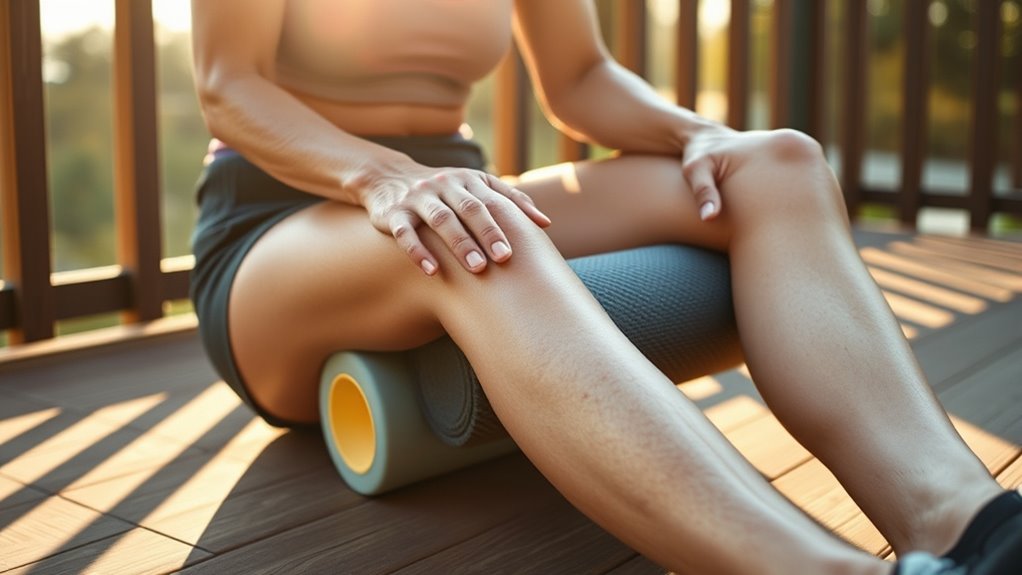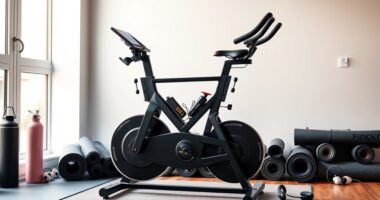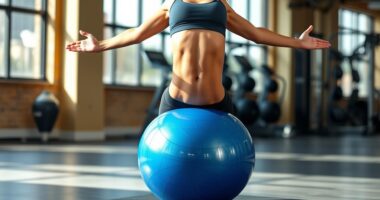Foam rolling after 40 helps improve your flexibility and range of motion by releasing fascia and loosening muscles that tend to tighten with age. It reduces muscle soreness, tightness, and joint pain, making daily movements easier and more comfortable. Foam rolling also boosts circulation, speeds recovery, and supports better posture, reducing strain on your spine and joints. Plus, it promotes relaxation and stress relief, leaving you feeling more balanced. Keep going to discover how to maximize these benefits for your well-being.
Key Takeaways
- Enhances flexibility, range of motion, and posture by releasing fascia and reducing muscle tightness.
- Reduces muscle soreness, stiffness, and joint pain, supporting smoother recovery and improved mobility.
- Boosts circulation and accelerates recovery, promoting overall vitality and vascular health.
- Promotes relaxation, stress relief, and mental well-being through mindful movement and endorphin release.
- Supports muscular balance and spinal health, preventing strain and improving posture with regular use.
Enhances Flexibility and Range of Motion
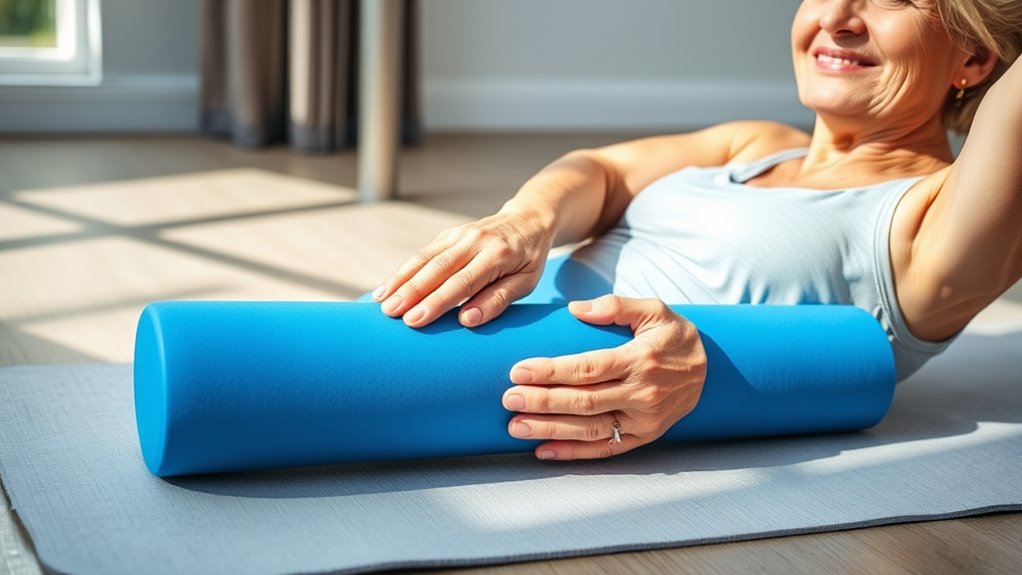
As you age, your muscles tend to tighten and become less pliable, which can limit your movement. Foam rolling helps by promoting fascia release, breaking up adhesions that restrict flexibility. Incorporate dynamic stretching after foam rolling to further enhance your range of motion, as it encourages your muscles to move through their full length safely. Regular foam rolling warms up your tissues, making them more receptive to stretching and movement. This combination improves flexibility, helping you perform daily activities more easily and reducing injury risk. Using proper foam rolling techniques can maximize benefits and prevent injury. Additionally, understanding the muscle and fascia structure can help you target your foam rolling more effectively. Applying myofascial release principles during foam rolling can further enhance tissue elasticity and mobility. Consistent practice can lead to noticeable improvements in your overall flexibility and ease of motion.
Reduces Muscle Soreness and Tightness

Foam rolling can help ease muscle soreness after your workouts, making recovery smoother. It also loosens tight muscles, reducing discomfort and stiffness. By incorporating foam rolling, you’ll feel less pain and move more freely throughout your day. Additionally, targeting specific muscle groups with foam rolling can improve muscle flexibility, further enhancing your overall mobility and reducing the risk of injury.
Alleviates Post-Workout Discomfort
After a tough workout, muscle soreness and tightness can linger, making movement uncomfortable and recovery slower. Foam rolling benefits are particularly noticeable here, as they help reduce discomfort and speed up post workout recovery. Using a foam roller targets tight muscles, easing knots and increasing blood flow. Incorporating mindful decluttering strategies during recovery can also promote mental clarity and overall well-being. Additionally, understanding muscle recovery techniques can optimize your post-exercise routine for better health.
Enhances Flexibility and Mobility
Regularly foam rolling helps improve your flexibility and mobility by reducing muscle soreness and tightness. Choosing the right foam density is key; a medium-density foam provides effective pressure without causing discomfort, especially as you age. Using proper rolling technique, such as slow, controlled movements over each muscle group, ensures you target tight spots effectively. Incorporating foam rolling into your routine can help prevent age-related decline, ensuring you stay active and agile. Additionally, understanding the benefits of foam rolling can motivate consistency in your practice. Being mindful of your muscle response during rolling can help you avoid overstimulation or injury, making your routine safer and more effective.
Promotes Faster Recovery After Exercise
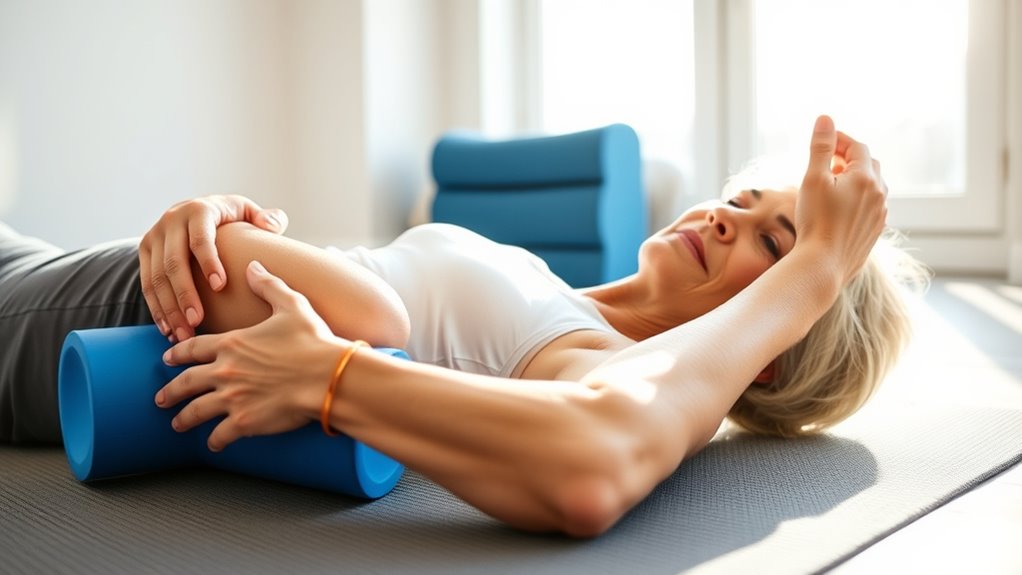
Because your body’s recovery process can slow with age, incorporating foam rolling into your post-exercise routine can considerably speed things up. Foam rolling encourages muscle relaxation, reducing tension that builds during exercise. It also aids in injury prevention by releasing tight spots before they cause strain or damage. Here’s how it helps you recover faster:
Foam rolling speeds recovery by relaxing muscles and preventing injuries.
- Breaks down adhesions and scar tissue, improving flexibility.
- Promotes muscle relaxation, easing soreness.
- Stimulates the release of endorphins, reducing pain.
- Accelerates toxin removal, helping muscles recover quicker.
- Supports muscle recovery by leveraging techniques used in automation to analyze and optimize physiological processes. Additionally, regular foam rolling can enhance flexibility over time, contributing to more effective workouts and reduced injury risk. Incorporating targeted techniques can further improve the effectiveness of your recovery routine, especially when combined with understanding store hours to plan visits around your schedule.
Improves Circulation and Blood Flow

Foam rolling stimulates blood flow and improves circulation, which is especially beneficial as you age. Better blood circulation enhances your circulatory health by delivering oxygen and nutrients more efficiently to muscles and tissues. When you roll over tight or sore areas, you encourage blood vessels to expand, increasing blood flow to those regions. This process helps remove metabolic waste and reduces muscle stiffness, promoting overall vitality. As you get older, maintaining healthy circulation becomes essential for energy levels, healing, and preventing issues like varicose veins. Incorporating foam rolling into your routine can support these goals by naturally boosting blood flow. Regularly practicing foam rolling can also help prevent circulatory issues and promote long-term vascular health. Improving vascular health is crucial for maintaining mobility and reducing the risk of cardiovascular problems. Enhanced circulation from foam rolling can also aid in muscle recovery, leading to quicker healing after workouts or injuries. With consistent practice, you’ll notice improved circulation, which can lead to better endurance, faster recovery, and enhanced well-being.
Supports Better Posture and Alignment
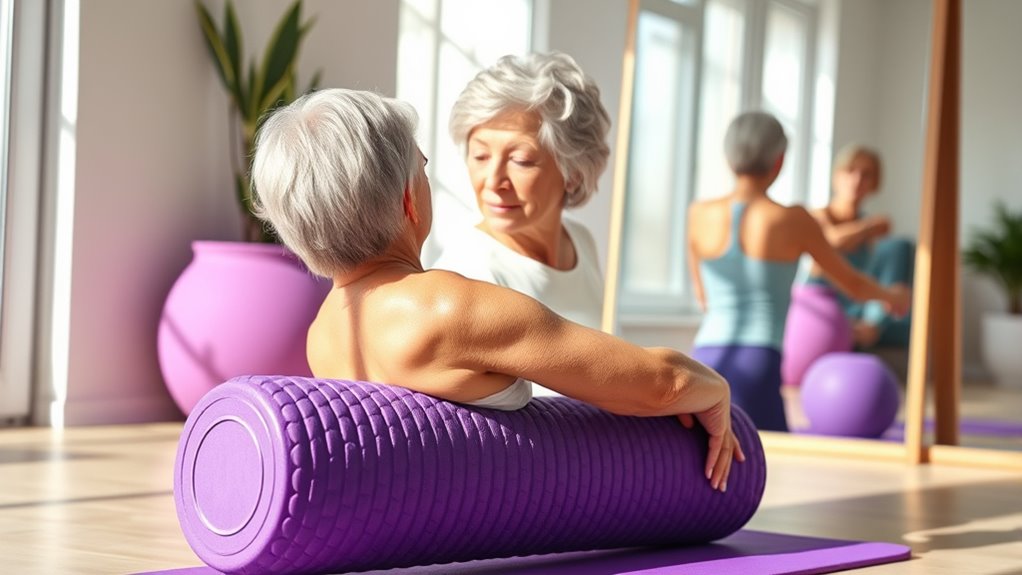
Foam rolling helps improve your spinal alignment by releasing tight muscles that pull your posture out of balance. It also eases muscular tension, making it easier to stand and move correctly. As a result, your posture becomes more natural and sustainable over time. Incorporating regular foam rolling sessions can also support muscle recovery and prevent injuries, further enhancing your overall posture and well-being. Additionally, understanding cybersecurity measures can help protect your personal information during online activities related to health and fitness. Being aware of cultural differences in health practices can also guide more effective and respectful wellness routines tailored to diverse populations. Embracing a creative practice approach, such as experimenting with different foam rolling techniques, can lead to more personalized and effective routines.
Enhances Spinal Alignment
As you age, maintaining proper spinal alignment becomes increasingly important for overall health and comfort. Foam rolling can play a key role in enhancing spinal alignment and supporting posture correction. Regularly targeting your back muscles helps improve spinal health by reducing restrictions and promoting flexibility. This, in turn, encourages better posture and reduces strain on your spine. Imagine:
- Loosened muscles around your spine, allowing for natural alignment
- Reduced muscle tightness that pulls your posture out of line
- Improved movement, making daily activities easier and less painful
- Enhanced awareness of your posture, encouraging ongoing correction
- Incorporating proper care and professional guidance into your routine can help you understand and maintain proper ergonomic habits for better spinal health. Recognizing the importance of RMDs and planning accordingly can further support your overall retirement and health goals.
Relieves Muscular Tension
Relieving muscular tension is essential for maintaining good posture and proper alignment, especially as you age. Foam rolling facilitates trigger point therapy by targeting knots and tight spots in your muscles. This helps break up adhesions and promotes fascia release, which reduces overall muscle tightness. When muscles are less tense, you’ll experience less strain on your joints and spine, supporting better posture. Regular foam rolling can prevent chronic discomfort caused by tension buildup, keeping your muscles more flexible and responsive. By easing tightness, you also improve blood flow, which aids recovery and reduces soreness. Incorporating foam rolling into your routine can also support muscle health, ensuring your muscles stay resilient and functional as you age. Additionally, foam rolling can positively influence your mind-body connection, fostering greater awareness of your body’s needs. Overall, incorporating foam rolling into your routine helps keep your muscles relaxed, preventing tension from negatively impacting your posture and ensuring your body stays aligned and functional.
Promotes Proper Posture
Maintaining proper posture becomes increasingly important as you age, and foam rolling can play a key role in supporting this. It aids in postural correction and enhances spinal health, helping you stand taller and move more comfortably. Regular foam rolling targets tight muscles that pull your posture out of alignment. Here’s how it helps:
- Loosens chest and shoulder muscles to prevent slouching
- Releases tension in back muscles for better spinal support
- Improves flexibility of hip flexors to maintain upright stance
- Enhances overall muscle balance, reducing strain on your spine
Eases Joint Pain and Stiffness
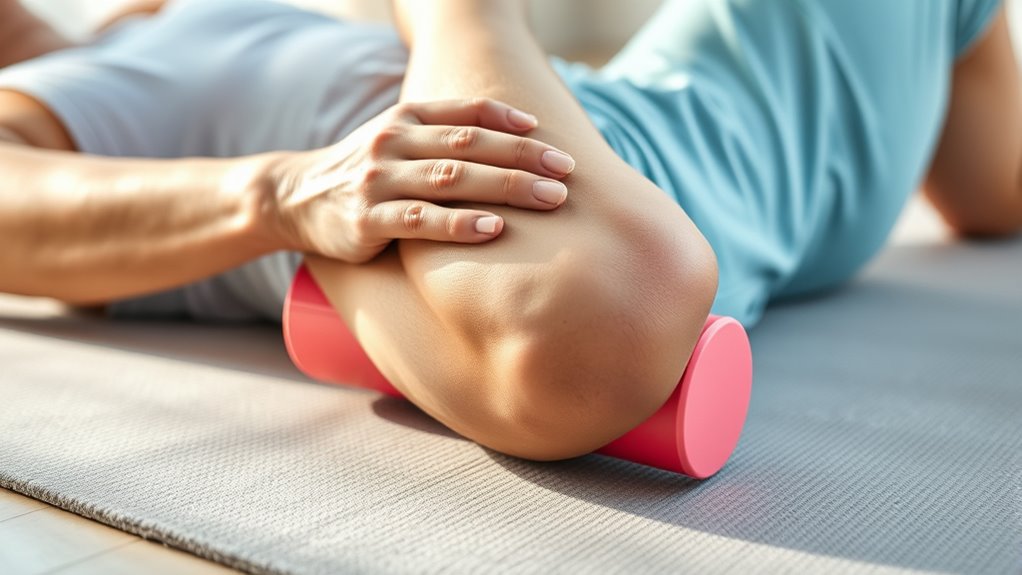
Foam rolling can considerably reduce joint pain and stiffness, especially as you age. By targeting muscles around your joints, it promotes better joint health and enhances flexibility. Regular foam rolling helps break down adhesions and improves blood flow, which supports pain management and reduces discomfort. When you roll over tight or sore areas, you release tension and increase mobility, making daily movements easier. This simple practice can ease the joint stiffness that often accompanies aging, helping you stay active and comfortable. Incorporating foam rolling into your routine can be an effective way to manage joint pain naturally, reducing reliance on medications. Consistent use not only alleviates stiffness but also supports long-term joint health, allowing you to move with less pain and more ease.
Boosts Overall Body Awareness and Movement Quality
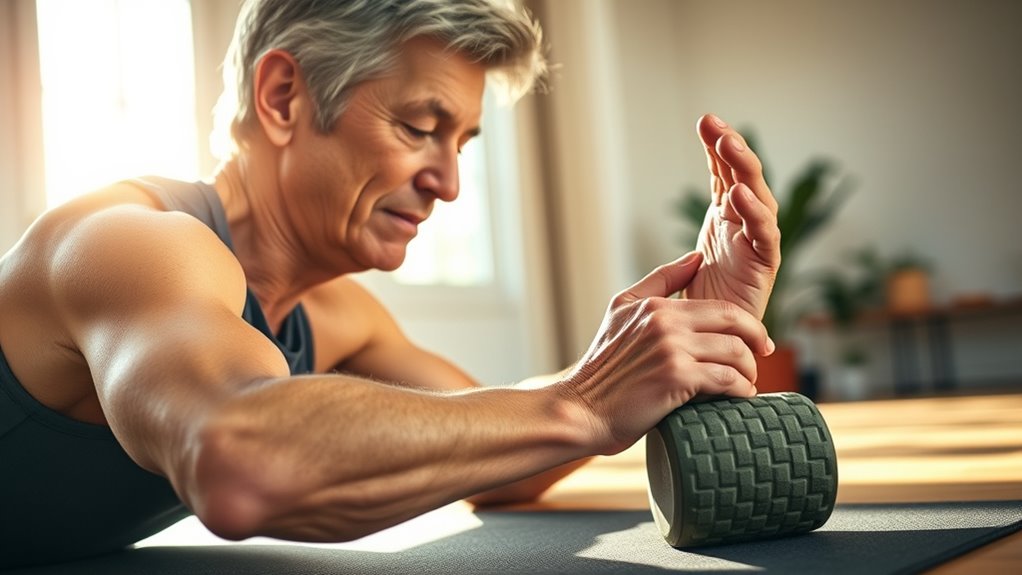
By improving the flexibility and reducing tension in your muscles through foam rolling, you naturally become more aware of how your body moves. This enhances your mind-body connection and sharpens proprioceptive awareness, helping you feel more in tune with your movements. As a result, you’ll notice better coordination and balance. To imagine this, visualize:
- Feeling more confident during everyday activities like bending or reaching.
- Recognizing subtle shifts in your posture before they cause discomfort.
- Moving with greater fluidity during exercise or stretching.
- Responding more quickly to changes in your body’s signals.
These improvements help you maintain better movement quality, reduce injury risk, and foster a deeper connection between your mind and body. Foam rolling therefore becomes a crucial tool for aging gracefully with improved body awareness.
Helps Manage Stress and Promotes Relaxation
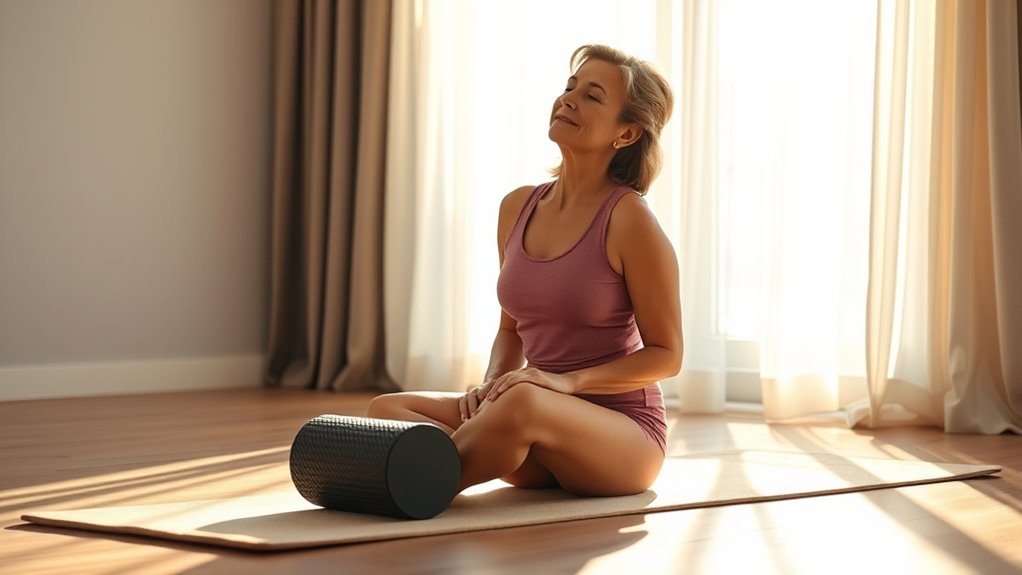
As you incorporate foam rolling into your routine, you’ll notice it has a calming effect that helps reduce daily stress. The gentle pressure and mindful movement encourage a mindfulness practice, helping you stay present and focused. Paired with breathing techniques—like slow, deep inhales and exhales—you can enhance relaxation and ease tension in your muscles. Foam rolling promotes the release of endorphins, which naturally boost your mood and reduce stress levels. As you focus on your body’s sensations during each roll, you create a moment of tranquility amid a busy day. Regularly integrating foam rolling with mindfulness and breathing exercises can improve your mental clarity, promote relaxation, and support overall stress management, especially as you navigate the challenges that come with aging.
Frequently Asked Questions
How Often Should I Foam Roll for Optimal Benefits After 40?
You should aim for 3 to 4 sessions per week to see results, but the frequency guidelines depend on your individual needs and how your body responds. To get the most from foam rolling, develop personalized routines that target your specific tight areas and avoid overdoing it. Listen to your body, and if you experience discomfort, reduce the frequency or intensity. Consistency is key for maintaining flexibility and reducing soreness after 40.
Are There Specific Foam Rolling Techniques Suited for Older Adults?
Did you know that 80% of adults experience muscle stiffness as they age? When foam rolling, you should focus on age-appropriate techniques, using gentle pressure to avoid discomfort. For older adults, slow, controlled movements work best, targeting major muscle groups without overdoing it. Always listen to your body, and consult a professional if you’re unsure. This approach helps improve flexibility and reduces soreness safely.
Can Foam Rolling Replace Stretching or Other Recovery Methods?
Foam rolling isn’t a complete replacement for stretching or other recovery methods, but it can serve as a helpful stretching alternative. It helps loosen tight muscles, increase blood flow, and improve flexibility, which supports injury prevention. Incorporate foam rolling into your routine alongside stretching and rest to optimize recovery. You’ll find it’s a valuable addition that enhances your overall mobility and reduces the risk of injury.
Is Foam Rolling Safe for People With Osteoporosis or Joint Issues?
You might wonder if foam rolling is safe for people with osteoporosis or joint issues. It’s essential to evaluate your bone density and joint comfort before trying it. Foam rolling can be gentle, but excessive pressure might cause discomfort or harm. Always consult your healthcare provider first, especially if you have osteoporosis or joint concerns. They can advise you on safe techniques to improve mobility without risking injury.
What Type of Foam Roller Is Best for Beginners Over 40?
As a beginner over 40, choose a foam roller with medium density to balance comfort and effectiveness. A length of about 36 inches works well for targeting larger muscle groups and maintaining stability. Avoid overly firm rollers that might cause discomfort or injury. Focus on controlled movements, and gradually increase intensity as your muscles adapt. This approach helps you get the most benefit safely and comfortably.
Conclusion
At any age, foam rolling boosts your mobility and eases soreness, but after 40, it becomes a game-changer. While your joints may feel stiffer and recovery slower, foam rolling helps you regain flexibility and stay active. It’s not just about physical benefits—it’s about reclaiming your confidence and comfort in movement. Don’t let age define your limits; let foam rolling empower you to move freely and feel your best every day.
